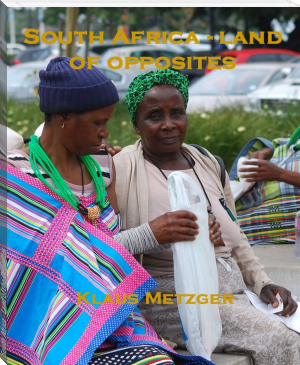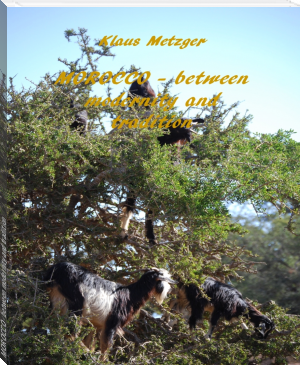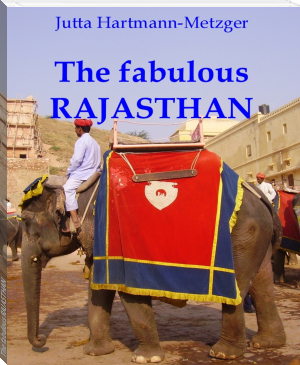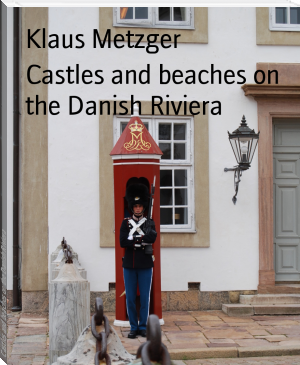Experiences with ARAB Countries by Klaus Metzger, Jutta Hartmann-Metzger (little red riding hood ebook free txt) 📕

- Author: Klaus Metzger, Jutta Hartmann-Metzger
Book online «Experiences with ARAB Countries by Klaus Metzger, Jutta Hartmann-Metzger (little red riding hood ebook free txt) 📕». Author Klaus Metzger, Jutta Hartmann-Metzger
We knew that in Essaouria the Muslim faith would be lived much more traditionally than in international Agadir. The veiled Moroccans were correspondingly photophobic. Some of them even reacted outraged when photographed. But Jutta had a "happy hand", a little less inhibitions and it got her very remarkable shots (without her the camera was torn out of hand as in the "Valley of the Kings" at Luxor 2003 in Egypt - only for a payment of 50 € she got him back without a movie at the royal tomb guards).
The Portuguese fort
After these exciting experiences in the old town we hiked to the fishing port. It was impossible to overlook the imposing fort that the Portuguese built in 1506 to demonstrate their economic interest in the North African coast. Everything still looks like it was just left yesterday. Even the big guns are still in battle position.
Place Moulay Hassan
After many impressions at the fishing port, we sat down at the "Place Moulay Hassan" on a bench and let the people pass us by (we had more than 2 hours until departure). Now we also felt we arrived in traditional Morocco - which was simply not possible in international Agadir. We were looking forward to our second trip to the former caravansary with the slave market, Taroudannt. Without much difficulty we returned to Agadir at 7 pm (distance about 220 km). A rewarding adventure with many impressions we had behind us.
Floral splendor in the garden of tea restaurant JNANE SOUSSIA
On Monday, April 23, 2012, it was time with the trip to Taroudannt. But this should only be a half day trip, because this time we only had to cover about 80 km. After driving over highways and a boring, flat landscape, we reached the fertile valley of the "Qued Sous". We were in one of the largest orchards in Morocco. The juicy Moroccan oranges we had previously met and loved it.
The tea restaurant JNANE SOUSSIA
At 9.30 we had a tea break of half an hour. We went to a beautiful and cool garden, where a free mint tea was served. Peppermint tea is also called "Moroccan whiskey" in Morocco and consists of green tea, into which smaller peppermint leaves are added. It tastes very refreshing and is always a pleasure.
Entrance gate to Taroudannt
After this refreshing break we drove the short way to one of the entrance gates of Taroudannt. We left the bus and joined the Moroccan tour guide Azizi Samir Abdelaziz (asamir@menara.ma) for a one-and-a-half hour walk through the souks of Taroudant. He spoke French, German and English and did a very good job.
Tour guide Azizi Samir Abdelaziz
Since he did not know my name, he suddenly called me during the tour "Ali Baba" (a baker had probably offered bread for tasting, which I should also taste). Being addressed with "Ali Baba" because of my gray beard was not new to me. Already in 2003 during our Nile cruise in Egypt they called me "Ali Baba". Incidentally, in 1954, the feature film "Ali Baba and the 40 robbers" with the French actor Fernandel ("Don Camillo and Peppone") was partly shot in Taroudannt - informed me the tour guide.
"Colorful Mix" in the Souk
The guided tours through the two souks were very impressive, inspiring the variety of goods and the different colors and smells changed from stand to stand. And again, it was very difficult to take pictures of the people - especially the sellers. Even after a completed purchase they were not ready to be photographed.
The Berber House
After completing our tour (around 11:30 am) Jutta and I visited the Berber house alone. I did not find it impressive (a ragbag of old and new decorative objects - I had expected a museum) and actually wanted to go again, because Jutta found a small, beautiful carpet, which she traded down from 1,600 to 800 dirhams (about 80 euros). Now this memorabilia adorns my office.
JUTTA: Pure relaxation at the swimming pool
KLAUS: Pure relaxation at the swimming pool
A special event that would complement our picture of Arab Morocco was the visit of the "Turkish Bath" (Hamam). It is already a tradition for us to visit the hammam in Arab countries. However, we only had the opportunity in Turkey so far. You can visit the hammam there together - but there is also the "Arab dress code": the parts of the pubis are covered with towels during the entire procedure.
In the hamam of the "Agadir Beach Club Hotel" all this was not possible: we had to visit the relatively small Haman separately. My session started at 10 am and ended an hour later. The scrub was excellent. The strong masseuse was proud to be able to show me some small "scratch pieces" of my skin. Even the face was not spared. In the afternoon, the women were allowed in the hamam. Jutta's shift started at 3pm. At 4 pm we met again in the fitness center. And then began the one-hour massage: Jutta with a woman and me with a man (and in separate rooms). Another experience that gives us a better understanding of Arab traditions!
Information:
MOROCCO - between Modernity and Tradition
4. OMAN - incense scents and great luxury
Frankincense Seller in Salalah / OMAN
When my wife, Jutta Hartmann-Metzger, called me OMAN (14.02 to 22.02.18) as my next destination, I immediately recalled the great significance that franchincense had meant for this Arab country for centuries. It took very long distances to sell this product to those interested in the Mediterranean.
The incense road from South Arabia to the Mediterranean is one of the oldest trade routes (see map: red color) of the world. About them was the incense from his native Dhofar (in the south-west of today's Oman with the capital Salalah), through Yemen, Asir (a mountainous province in southwestern Saudi Arabia) and the Hijaz in Saudi Arabia to the Mediterranean port of Gaza and transported to Damascus. Important trading stations on the incense road, which was operated as a caravan route were Shabwa (today's ruined city in Yemen), Sanaa (capital of the Jermen), Medina (Saudi Arbien) and Petra (today's ruins in Jordan).
Trade routes from 200 BC BC until 850 AD
The dried resin of the frankincense tree develops a fragrant aromatic smoke when burned (smoking). The incense has been used from time immemorial as a disinfecting and anti-inflammatory fumigant in medicine. As a remedy, it is highly sought after in non-European medicine and naturopathy. In addition, incense was and is used for religious worship, such as in the Catholic and Orthodox Churches. In the temples of almost all religions of the ancient world, he was considered a particularly valuable offering.
Jutta and the "Frankincense Tree" in the HAWANA Resort
I still have very pleasant memories of the strong frankincense scents during Holy Mass in the Catholic Church of my home church in Brühl. In combination with the impressive organ music, something started to resonate and I sang the well-known hymns with great fervor. Unfortunately, my interest in these uplifting moments was lost when I left Brühl (1967). Only about 30 years later I found in my second wife, Jutta Hartmann-Metzger, a partner who has similar feelings when visiting a Catholic church.
The development of the incense road was only by the domestication of the dromedary (with a hump) in the middle of the 2nd millennium BC possible. With the use of dromedaries as pack animals, the caravans were able to travel longer distances to the nearest waterhole in the desert. In addition to incense, the caravans also transported spices and precious stones from India and Southeast Asia to Palestine and Syria.
Near Petra, north of the Gulf of Aqaba, the incense road split into a northern branch with the terminus Gaza and an eastern one leading to Damascus. According to reports by ancient authors, camel caravans needed 100 days' marches for the 3,400 km stretch between Dhofar and Gaza.
The incense street was probably built in the 10th century BC. Used for the first time. However, there was a boom in trade only after the emergence of the southern Arabian kingdoms of Saba, Qataban, Hadramaut and Ma'in in the 8th century BC. The high demand for incense in cultic activities in the Mediterranean area has led since the 5th century BC. Chr. To a flowering of the route and the cities and kingdoms that connected them. At the turn of the century, the Roman Empire is said to have consumed 1,500 tons of estimated annual production of 2,500 to 3,000 tons of incense.
Shortly before, however, began the slow decline of the incense road. The Ptolemaic rulers of Egypt had in the 1st century BC Let the sea route through the Red Sea open up. This allowed them to enter the incense trade and avoid the high duties and charges levied on the land route. Not only did the old caravan route lose its importance. Even the ancient Arab kingdoms were gradually deprived of their economic basis. This led to the rise of the Himyars in Yemen in the 3rd century. They are now relying increasingly on agriculture in climatically more favorable mountainous areas and on the control of maritime trade.
The triumph of Islam since the 7th century meant another serious setback for the trade route. Frankincense was still used in Islamic medicine, but not in the religious sphere of mosques.
Frankincense sale in Salalah / OMAN
We still found a lively trade in frankincense in Salalah. There we visited a special incense market with the unmistakable smells in all directions. The incense grows on the barren slopes around Salalah under perfect conditions. To date, it is one of the most important agricultural products of Oman. The country, which is not so rich in oil as its neighbors, can not do without it. In addition, the promotion of tourism should bring additional revenue. The incense harvest itself is still a tedious and lengthy affair for the people.
With sharp knives the incense growers scratch trunk and branches in the harvest season between December and May. The first drops of resin are useless, but when scratched a second time later, the quality that lands on the bazaars comes. Around four weeks, the emerging wax must harden on the tree, before the farmers again pull from tree to tree and cut off the resin. But not only in Dhofar there are





Comments (0)